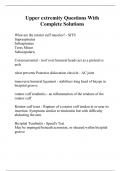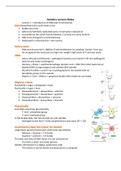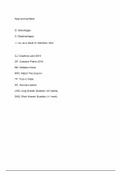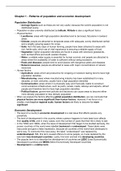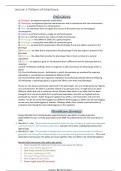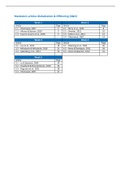Bioinformatica & Genoomanalyse Evelien Floor
Structural variation and copy
number variation
Structural variations in genomes
Types
Single nucleotide variations (SNV) are changes in a single base. Structural variations (SV) are changes
in the genome structure, most of the time a variation bigger than 20 base pairs. There are different
types of structural variations:
Deletion
Duplication
Inversion
Insertion
Translocation
Copy number variations (CNV) are changes in copy number of a segment of the genome (duplication,
deletion). Copy number variations are structural variations but not all structural variations are copy
number variations. Indels are small insertions or deletions defined as 1-20 base pairs. An inversion of
10 base pairs is also called an indel because it is hard to proof whether it was really an inversion or
just an insertion.
Larger structural variations are less frequent in the human population than SNV. Formation
mechanisms influence structural variations sizes (LINE, SINE).
Formation mechanisms
Recurrent structural variations or copy number variations occur through recombination of
paralogues repeats (Low copy repeat), leading to clustering of breakpoints. Non-recurrent structural
variations or copy number variations have ‘random’ non-clustered breakpoints.
There are different mechanisms that can cause formation of structural variations and copy number
variations:
Non-allelic homologous recombination between two identical sequences at different
genomic loci occurs during meiosis. Most often this leads to deletion or duplication of DNA in
progeny.
Non-homologous repair of double-stranded DNA break occurs when no homologous DNA
template is available (during G1 of the cell cycle). This may lead to formation of small
insertions and deletions or more complex changes.
Break-induced replication is the repair of a broken replication fork during the S phase (nick in
template strand). Re-initiation of DNA replication at paralogues sequence typically leads to
copy number variations formation.
Mobile element insertion occurs because of retrotransposons; LINE, SINE or LTR transposable
element.
Chromothripsis, shattering of one or more chromosomes leads to random reassembly of the
fragments. This results in complexly rearranged chromosomes. Typically involves deletions
(no duplications).
Molecular effects
SNP amino acid changes or truncating mutation leads to null allele
SV exon is deleted what causes a frameshift
CNV gene is duplicated what results in too many gene copies
Other molecular effects:
1
Structural variation and copy
number variation
Structural variations in genomes
Types
Single nucleotide variations (SNV) are changes in a single base. Structural variations (SV) are changes
in the genome structure, most of the time a variation bigger than 20 base pairs. There are different
types of structural variations:
Deletion
Duplication
Inversion
Insertion
Translocation
Copy number variations (CNV) are changes in copy number of a segment of the genome (duplication,
deletion). Copy number variations are structural variations but not all structural variations are copy
number variations. Indels are small insertions or deletions defined as 1-20 base pairs. An inversion of
10 base pairs is also called an indel because it is hard to proof whether it was really an inversion or
just an insertion.
Larger structural variations are less frequent in the human population than SNV. Formation
mechanisms influence structural variations sizes (LINE, SINE).
Formation mechanisms
Recurrent structural variations or copy number variations occur through recombination of
paralogues repeats (Low copy repeat), leading to clustering of breakpoints. Non-recurrent structural
variations or copy number variations have ‘random’ non-clustered breakpoints.
There are different mechanisms that can cause formation of structural variations and copy number
variations:
Non-allelic homologous recombination between two identical sequences at different
genomic loci occurs during meiosis. Most often this leads to deletion or duplication of DNA in
progeny.
Non-homologous repair of double-stranded DNA break occurs when no homologous DNA
template is available (during G1 of the cell cycle). This may lead to formation of small
insertions and deletions or more complex changes.
Break-induced replication is the repair of a broken replication fork during the S phase (nick in
template strand). Re-initiation of DNA replication at paralogues sequence typically leads to
copy number variations formation.
Mobile element insertion occurs because of retrotransposons; LINE, SINE or LTR transposable
element.
Chromothripsis, shattering of one or more chromosomes leads to random reassembly of the
fragments. This results in complexly rearranged chromosomes. Typically involves deletions
(no duplications).
Molecular effects
SNP amino acid changes or truncating mutation leads to null allele
SV exon is deleted what causes a frameshift
CNV gene is duplicated what results in too many gene copies
Other molecular effects:
1


